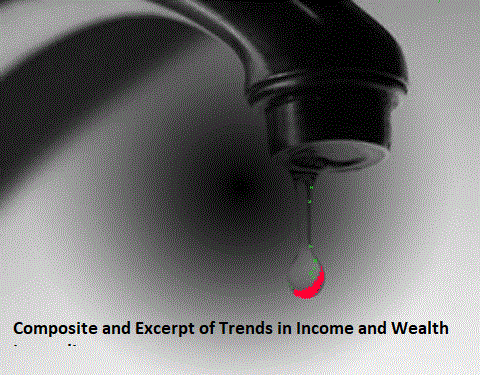Composite of excerpts from PEW Research Center (pewresearch.org) contributors Juliana Menasche Horowits, Ruth Igielnik, Rakesh Kochnar, Katherine Schaeffer, CBS News (cbsnews.com), and the Center for Budget and Policy Priorities (cbpp.org). Links are below, for complete articles. From 1970 to 2018, the median middle-class income increased from $58,100 to $86,600, a gain of 49%. By comparison, the median income for upper-tier households grew 64% over that same time, from $126,100 to $207,400. The share of American adults who now live in middle-income households has decreased from 61% in 1971 to 51% in 2019. Keep in mind, the bulk of taxes collected by the U.S. comes from the Middle Class.
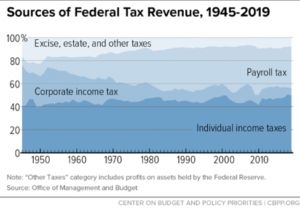
“In fiscal year 2019, the federal government spent $4.4 trillion on the services it provides, such as national defense, health care programs like Medicare and Medicaid, Social Security benefits for the elderly and disabled, and investments in infrastructure and education, in addition to interest on the debt (see our related Policy Basics: Where Do Our Federal Tax Dollars Go?). Federal revenues financed over $3.5 trillion of that $4.4 trillion. Borrowing financed the remaining amount ($984 billion).
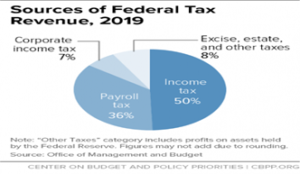
Sources of Federal Tax Revenue, 2019. Half of all federal revenue (50 percent) comes from individual income taxes. The income tax is generally progressive: higher-income households generally pay a larger share of their income in income taxes than lower-income households do.” – Policy Basics: Where Do Federal Tax Revenues Come From? – August 6, 2020, cbpp.org/research
With the exportation of American jobs, came the collapse of the Unions, which for one, I’ve never been a big fan of. Lessons learned, and with the collapse of the Unions; the medium incomes for the Middle Class, also dropped; taking with it the major U.S. Tax base.
As with the collapse in the U.S. Tax base, witness a collapse in the number of people who could then afford medical care, as well as quality care and education for their children. This all didn’t happen overnight, folks. Neither did the need for the very thought of the Affordable Care Act, which Mick Romney first pushed, while in Massachusetts.
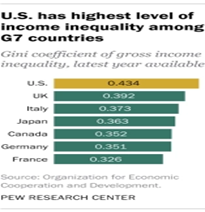
Add to this subsequent business and financial collapses in the financial and now, commercial businesses; and with the Middle Class still bearing the brunt of the financial tax burden, while the supposed prominent businesses held hands out for bailouts; receiving subsidies. Pseudonyms for economic Socialism, hardly benefitting the Middle or Lower Income earners, except through an assumed trickle-down effect of business prosperity.
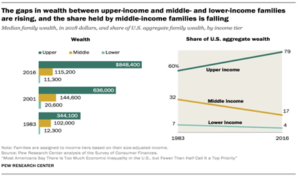
The black-white income disparity in the U.S. has persisted throughout. The differences in median household incomes between white and black Americans grew from around $23,800 in 1970 to roughly $33,000 in 2018 (as measured in 2018 dollars). Median black household income was 61% that of median white household income in 2018, rising modestly from 56% in 1970 – but down slightly from 63% in 2007, before the Great Recession, according to Current Population Survey data.
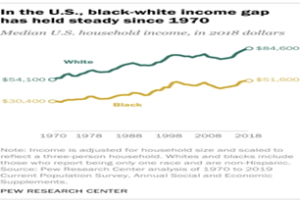
“Over the next two years, income for Middle-Class Americans is projected to grow at less than half the rate as for the richest 1%, a recent Congressional Budget Office found. Income growth under Trump has done little to close the income disparity among the Middle Class, who pay the majority of taxes, and the upper 3%, who have the majority of Tax breaks.” A quote from an article titled, Two years after Trump tax cuts, middle-class Americans are falling behind, by Aimee Picchi, December 31, 2019, MoneyWatch.
Overall, 61% of Americans say there is too much economic inequality in the country today, but views differ by political party and household income level. Among Republicans and those who lean toward the GOP, 41% say there is too much inequality in the U.S., compared with 78% of Democrats and Democratic leaners, a Pew Research Center survey conducted in September 2019 found.
Add to this; the country’s top-earning households will also be enjoying a bigger decline in tax rates, than all other groups. Resulting in a growing U.S. income inequality, already at a 50-year high; expected to worsen.
References:
Two years after Trump tax cuts, middle-class Americans are falling behind – December 31, 2019 – https://www.cbsnews.com/news/two-years-after-trumps-tax-reform-the-middle-class-is-struggling/
Policy Basics: Where Do Federal Tax Revenues Come From – Updated August 6, 2020 https://www.cbpp.org/sites/default/files/atoms/files/PolicyBasics_WhereDoFederalTaxRevsComeFrom_08-20-12.pdf
6 Facts About Income Inequality In the U.S. – by Katherine Schaeffer – February 7, 2020 – https://www.pewresearch.org/fact-tank/2020/02/07/6-facts-about-economic-inequality-in-the-u-s/
Trends in income and wealth inequality – by Jliana Menasce Horowitz, Ruth Igielnik and Rakesh Kochar – January 9, 2020 – Pew Research Center – https://www.pewsocialtrends.org/2020/01/09/trends-in-income-and-wealth-inequality/

